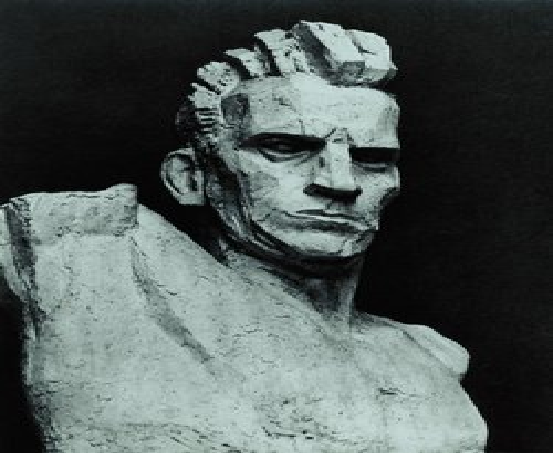Title of Product:
Ksawery Dunikowski- virtuosity sculptor and generator of the original style
Country:
 Poland
Poland
Century: 1900 - The 20th Century
Topic: Ksawery Dunikowski- virtuosity sculptor and generator of the original style
Image of the product:

Name of Author(s): Piotr Szubert
Name of Producer: Net periodic: “culture.pl”
Language/s of Product: Polish
Target Group: General audience
Website last update: http://www.culture.pl/pl/culture/artykuly/os_dunikowski_xawery
http://pl.wikipedia.org/wiki/Xawery_Dunikowski
Overall Evaluation: excellent
Availability of community:
Newsgroup
Objectives & Structure:
Aspects to consider:
- The students catch the idea of the sculptures’ modifications especially as regards the formulas of geometry, sphere’s horizons and monumentality
- The students may consciously follow the artistic instruments according the style observed in the sculpture, its influences and perspectives
- The cohabitations between the styles, the specific performances connected with epoch’s spirit and required manifestations on the artistic forum
- Possibility of constructing a case- study according the artistic declarations and the plots dominating in the artist’s expression as regards the sculpture’s performance effect
Description of contents:
Ksawery (Xawery) Dunikowski was a sculptor and a painter. In his career, he was also nominated a Professor of Sculpture in the Academy of Fine Arts in Warsaw.
His creative path was featured by many sides of an artist’s deep consideration and the abundance as regards the original worked out, individually manifested solutions.
In the beginnings of his performing, he was under a noticeable influence of Auguste Rodin. It was proved in a sensitive, full of chiaroscuro subtleties way of composing the acted in form. However, soon in the initial years of XX century, he worked out his own original style, that way ending off with the Rodin’s type mannerism observable within the Polish sculpture’s vision.
In his most recognizable masterpieces-as ”Breath”, or “Fate”, he entirely reached the power of his expression resulted from the details’ crossing out, and his dedication towards the aggregate, in a half way abstracted, decisively construed sphere.
The themes and atmosphere of the artist’s objects from that period corresponded with the spirit of the Polish Modernism and the theoretical artistic declarations put forward by Stanislaw Przybyszewski – the most essential personage of the epoch’s vision, coming from the Cracow’s environment.
Przybyszewski insisted on the artists’ abandoning the academic conventions and composing the masterpieces under the influence of the direct power of the sheer spirit. The artist was to express his subjective feelings, not to know the compromises, and to be subjected to the impulses originated from his existence.
During his staying in Paris, Dunikowski made sculptures established in their geometrical embodiments, coming close to the abstraction’s imperative.
The most symptomatic masterpieces illustrating that tendency were: his self portrait (“I am going towards the sun”). and the Grave of Boleslaw the Brave (the Polish King).
In his self portrait, the muscular posture of the figure was put down to deformations- suggesting that it was under the power of the distinctive physical laws, different than those found within the Euclidian’s space.
The polychrome of the background developed itself together with the personage’s figure and constituted 3 triangles bearing a resemblance of he sunlight’s spectrum fissured into 3 main colours. That glorifying aspect was bound to the upper part of the composition, while in its bottom the figure remained influenced by the darkness of the earthly condemnation.
That artistic counter point seems to draw viewers’ attention towards the inset irresistible human being’s dichotomy, the allegory of the commonly present Prometheus’s predilection. Additionally, in spite of the remarkable size, when standing in front of the composition, one can sensually perceive the lack of the figure’s physical basement, its lack of an element of hanging on in the undefined space.
The Grave of Boleslaw the Brave is said to be one of the most spectacular Polish monumental conceptions in the course of the artistic life of XX century.
The king’s honour is mixed together with the outcast’s bad fortune.
Dunikowski seems to have been inspired by the character’s distinctiveness in Stanislaw Wyspianski’s drama of the correspondent theme.
The great monumental expression was reached through the spectacular abstractive motive of the inner movable attitude of the spheres’ setting from up to down one by one.
Evaluation and Comments:
Overall Evaluation: excellent
Clarity of structure, logical sequence of contents: excellent
Usability / easiness of navigation: excellent
The website is interesting / stimulating: excellent
Educational and learning value: excellent
Quality and relevancy of content: excellent
Compatibility of the content with the target group: excellent
Suitability and quality of graphic interface: excellent
Degree and quality of interaction: excellent
Exploitation of the electronic potential: excellent
Availability and quality of simulation exercises: excellent
Quality of the evaluation tools: excellent
Possibility of printing/saving material or tests: excellent
Description of how the website can be used with the students::
- The website demonstrates the sources of artistic findings by the original artist and the directions he was developing consequently.
Comments::
- Students grasp the sculptures’ ideas in the aspects of building the specific monumentality, witty geometrical sphere’s collocations, abstractions hanged on the severe physical constitution
Evaluation Date: 01.09.2008.
Name of teacher: Antoni Woźniak
Name of School: LO number 3
Country: Poland
Subjects Taught: Fine Arts
Comments about this product

 Poland
Poland